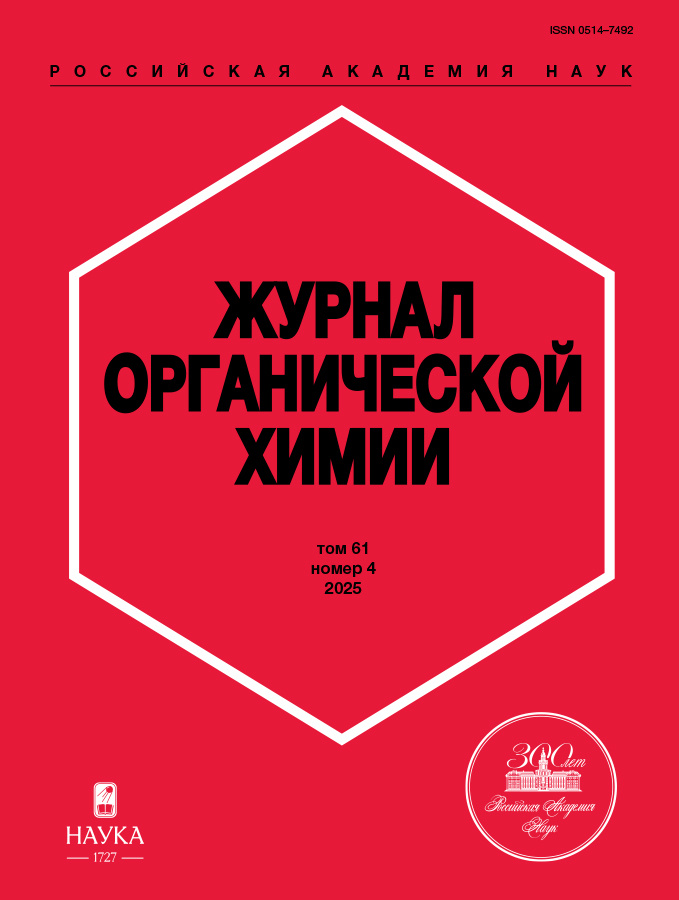Synthesis and antituberculosis activity of new 5-alkynyl derivatives of 2-thiouridine: application of new scaffold
- Authors: Platonova Y.B.1, Kirillova V.A.1, Volov A.N.1, Savilov S.V.1,2
-
Affiliations:
- Lomonosov Moscow State University
- Kurnakov Institute of General and Inorganic Chemistry, Russian Academy of Sciences
- Issue: Vol 59, No 12 (2023)
- Pages: 1598-1607
- Section: Articles
- URL: https://www.clinpractice.ru/0514-7492/article/view/667153
- DOI: https://doi.org/10.31857/S0514749223120042
- EDN: https://elibrary.ru/NZISZG
- ID: 667153
Cite item
Abstract
We herein describe new potent inhibitors of mycobacteria based on 5-substituted 2-thiouridine derivatives. A series of new 5-alkynyl-substituted 2-thiouridine derivatives were synthesized via palladium-catalysed Sonogashira cross-coupling reaction of 5-iodo-2-thiopyrimidine base with terminal acetylenes with good yields in DMF at room temperature. It was found that sulfur atom in C2 position of pyrimidine ring had no impact on yields of target compounds. All obtained compounds were evaluated for their antimycobacterial activity against Mycobacetrium bovis and Mycobacterium tuberculosis at concentrations of 0.1-100 µg/ml using MABA test. Synthesized nucleosides showed high antimycobacterial activity against Mycobacterium bovis and Mycobacteri um tuberculosis. The obtained MIC50 values of 2-thionucleosides 14, 15 and 16 (0.28-0.75 µg/ml) significantly exceed characteristics of reference drug rifampicin, D-cycloserine and isoniazid, which gives prerequisites for further more detailed studies.
About the authors
Ya. B. Platonova
Lomonosov Moscow State University
Email: knoposk@gmail.com
V. A. Kirillova
Lomonosov Moscow State University
A. N. Volov
Lomonosov Moscow State University
S. V. Savilov
Lomonosov Moscow State University;Kurnakov Institute of General and Inorganic Chemistry, Russian Academy of Sciences
References
- World Health Organization. Global Tuberculosis Report. World Health Organization. Geneva, Switzerland. 2021.
- World Health Organization. Global Tuberculosis Report. World Health Organization. Geneva, Switzerland. 2014.
- Zumla A., Nahid P., Cole S.T. Nat. Rev. Drug Discov. 2013, 12, 388-404. doi: 10.1038/nrd4001
- Klopper M., Warren R.M., Hayes C., van Pittius N.C.G., Streicher E.M., Muller B., Sirgel F.A., Chabula-Nxiweni M., Hoosain E., Coetzee G., Trollip A.P. Emerg. Infect. Dis. 2013, 19, 449-455. doi: 10.3201/eid1903.120246
- Slomski A. J. Am. Med. Assoc. 2013, 309, 1097-1098. doi: 10.1001/jama.2013.1802
- Koul A., Arnoult E., Lounis N., Guillemont J., Andries K. Nature. 2011, 469, 483-490. doi: 10.1038/nature09657
- Fernandes G.F.S., Jornada D.H., Souza P.C., Man Chin C., Pavan F.R., Santos J.L. Curr. Med. Chem. 2015, 22, 3133-3161. doi: 10.2174/0929867322666150818103836
- Bloemberg G.V., Keller P.M., Stucki D., Trauner A., Borrell S., Latshang T., Coscolla M., Rothe T., H�mke R., Ritter C., B�ttger, E.C. N. Engl. J. Med. 2015, 373, 1986-1988. doi: 10.1056/NEJMc1505196
- Zhang S., Chen J., Cui P., Shi W., Shi X., Niu H., Chan D., Yew W.W., Zhang W., Zhang Y. Antimicrob. Agents Chemother. 2016, 60, 2542-2544. doi: 10.1128/AAC.02941-15
- Segala E., Sougakoff W., Nevejans-Chauffour A., Jarlier V., Petrella S. Antimicrob. Agents Chemother. 2012, 56, 2326-2334. doi: 10.1128/AAC.06154-11
- Srivastav N.C., Manning T., Kunimoto D.Y., Kumar R. Bioorg. Med. Chem. 2007, 15, 2045-2053. doi: 10.1016/j.bmc.2006.12.032
- Srivastav N.C., Rai D., Tse C., Agrawal B., Kunimoto D.Y., Kumar R. J. Med. Chem. 2010, 53, 6180-6187. doi: 10.1021/jm100568q
- Platonova Ya.B., Volov A.N., Tomilova L.G. Bioorg. Med. Chem. Lett. 2020, 30, 127351. doi: 10.1016/j.bmcl.2020.127351
- Shigi N. Front. Genet. 2014, 5, 1-11. doi: 10.3389/fgene.2014.00067
- Jackman J.E., Alfonzo J.D. Wiley Interdiscip. Rev. RNA. 2013, 4, 35-48. doi: 10.1002/wrna.1144
- Hilbert G.E., Johnson T.B. J. Am. Chem. Soc. 1930, 52, 4489-4494. doi: 10.1021/ja01374a045
Supplementary files











